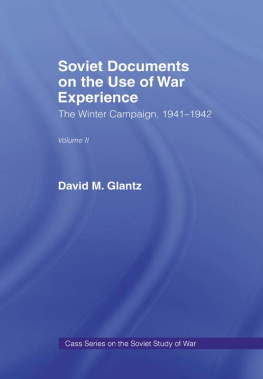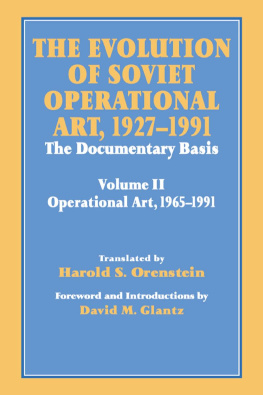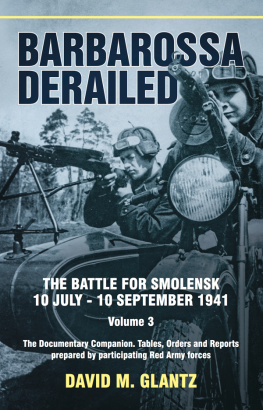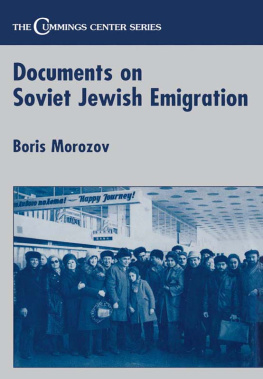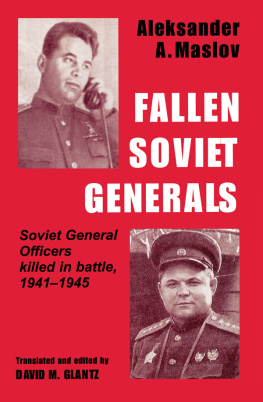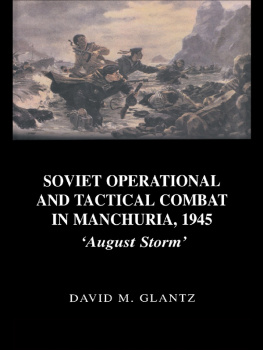CASS SERIES ON THE SOVIET STUDY OF WAR NO.2
SOVIET DOCUMENTS ON THE USE OF WAR EXPERIENCE
VOLUME II
The Winter Campaign 19411942
CASS SERIES ON THE SOVIET STUDY OF WAR
(Selected Translations)
Series Editor David M. Glantz
Ft. Leavenworth, Kansas
This series examines that Soviet military theorists and commanders have learned from the study of their own military operations. Separate volumes contain annotated translations of Soviet works analyzing their war experiences as well as the works of important Soviet military theorists and collections of Soviet articles concerning specific campaigns, operation, or military techniques.
- Harold S. Orenstein, translator and editor, Soviet Documents on the Use of War Experience, Volume I, The Initial Period of War 1941, with an Introduction by David M. Glantz
- Harold S. Orenstein, translator and editor, Soviet Documents on the Use of War Experience, Volume II, The Winter Campaign 19411942, with an Introduction by David M. Glantz
- Joseph Welsh, translator, Red Armor Combat Orders; Combat Regulations for Tank and Mechanized Forces, 1944, with an Introduction by Richard N. Armstrong
SOVIET DOCUMENTS ON THE USE OF WAR EXPERIENCE
VOLUME TWO
The Winter Campaign 19411942
Translated by
HAROLD S. ORENSTEIN
Soviet Army Studies Office
Combined Arms Center, Fort Leavenworth, KS
With an Introduction by David M. Glantz
First published 1991 in Great Britain by
FRANK CASS & CO. LTD.
2 Park Square, Milton Park,
Abingdon, Oxon, OX14 4RN
and in the United States of America by
FRANK CASS
270 Madison Ave,
New York NY 10016
Transferred to Digital Printing 2006
Copyright 1991 Frank Cass & Co.
British Library Cataloguing in Publication Data
Soviet documents on the use of war experience.
Vol. 2.
1. World war 2: Military operations
940.541247
ISBN 0-7146-3393-3
Library of Congress Cataloging-in-Publication Data
Soviet documents on the use of war experience / translated by Harold
S. Orenstein ; with an introduction by David M. Glantz.
2 v.; cm. (Cass series on the Soviet study of war ; no. 12)
Translated from the Russian.
Includes bibliographical references.
Contents: v. 1. The initial period of war, 1941, v. 2. The
Winter Campaign 19411942.
ISBN 0-7146-3392-5 (v. 1). ISBN 0-7146-3393-3 (v. 2)
1. World War, 19391945 Campaigns Soviet Union.
I. Orenstein, Harold S. (Harold Steven), 1948
II. Series.
U740.S68 1991
940.541247 dc20
9111452
CIP
All rights reserved. No part of this publication may be reproduced in any form or by any means, electronic, mechanical, photocopying, recording or otherwise, without the prior permission of Frank Cass and Company Limited.
Typeset by Selectmove Ltd
Publisher's Note
The publisher has gone to great lengths to ensure the quality of this reprint but points out that some imperfections in the original may be apparent
CONTENTS
INTRODUCTION
This volume is the second in a series of works prepared by the Red Army General Staff and published by the Soviet Commissariat of Defense, containing collected materials for the study of war experience. In November 1942 the General Staff ordered the creation of a system for collecting, analyzing, and generalizing war experience to enable the Red Army to adjust to the changing nature of war. The order was driven by necessity in the form of two major strategic defeats inflicted on the Red Army by the German Army in June 1941 and in May 1942. It was clear to the General Staff that improvements would have to occur in a host of tactical and operational realms if the Red Army was to reverse the tide of war.
The concept of analyzing war experience was not a new one for the Soviets. Since the 1920s the Red Army General Staff had been wedded to the view that an army prepared for contemporary and future war by understanding the nature of past wars and technological change. Most of the progressive changes which occurred in the Red Army of the 1920s and 1930s resulted from the analysis of war experience. Unhappily for the Soviets, in the late 1930s the misfortunes which befell the Soviet military occurred in part because of an absence of sound analysis of contemporary operations, due in part to the purges, which deprived the Red Army of its most brilliant thinkers.
After the outbreak of war in 1941, the General Staff encouraged operating fronts to institute their own programs for analyzing war experiences. The results were mixed. While some fronts, most notably the Western, established effective programs, others did not. The November order published in this volume relates the unevenness of the effort and recommends remedies to that situation. The first volume of war experiences, published under the auspices of the order in July and August 1942, undoubtedly contains some material from those earlier analytical efforts. This volume, the second, analyzes Red Army experiences prior to the creation of the new system, principally during the winter campaign of 194142. Rather than focusing on facets of a single operation, this second volume contains detailed studies on a wide range of operational and tactical themes involving both combat and combat support functions.
These studies accurately and candidly portray the nature of combat on the Eastern Front. Understandably, at this stage in the war they recount failure more often than success, but always in the belief that failure teaches those who survive. These war experience analyses accentuate the practical and concentrate on what works in real combat. This fixation on the often mundane functions of tactical combat reflects the Soviet belief that grand concepts succeed or fail depending on how the lowliest infantryman, sapper, gunner, or tankist performs his grisly task. Although perhaps this approach is best suited to an army which has at its disposal imposing manpower reserves, the results attained speak for themselves. The Red Army did educate itself during the war and emerged a modern, potent fighting force.
This second volume of war experiences was published by the General Staff in September-October 1942. Although all of its chapters are instructive, some made particular contributions to the future success of the Red Army. The first four sections address aspects of combat during the winter of 194142 in the expectation that those experiences would better equip the Red Army in its 194243 winter campaign, which was about to commence on 19 November at Stalingrad.
While surveying the vast panoply of operational and tactical questions arising from operations the previous winter, the analyses focus particularly on maneuver of forces in winter and on fire support. Soviet concern over the failure of its mobile forces to encircle German forces at Moscow in 1941 emerges as central. So also does Soviet concern over its failure to deploy, coordinate, and mass the firepower necessary to overcome German defenses. The General Staff well knew that if it could not overcome defenses which were thin and often hasty in 1941, it would have even more difficulty overcoming better prepared defenses in 1942. Consequently, this volume of war experiences thoroughly assesses the operations of one of the few types of units capable of maneuvering in winter, ski troops.

